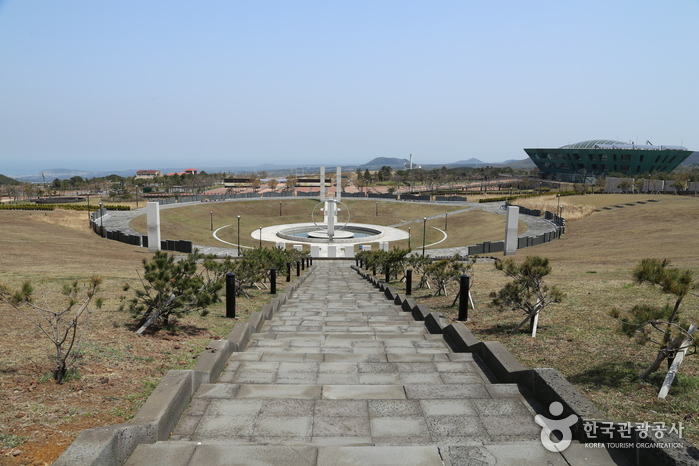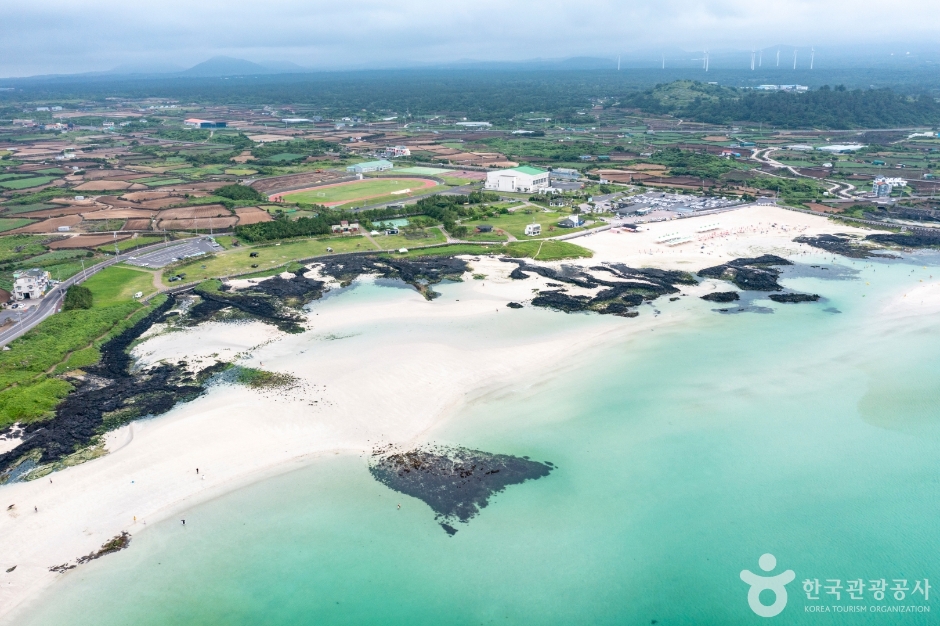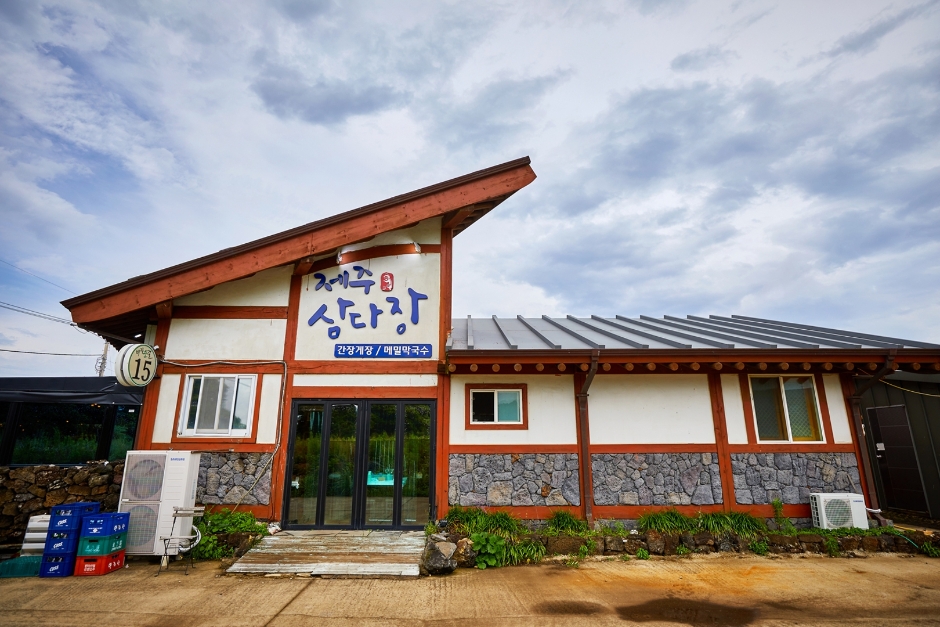Roe Deer Observation Center (제주 노루생태관찰원)
8.5Km 2020-12-03
520, Myeongnim-ro, Jeju-si, Jeju-do
+82-64-728-3611
Roe Deer Observation Center opened on August 3, 2007 to offers a place where visitors may observe and watch roe deer and other creatures in their natural habitat. Guests can watch the deer from the forest trails, or feed them at the experience enclosure. The exhibition hall offers information on Hallasan Mountain and the animals and plants that live around it, including a video room teaching about the life of a roe deer. The observation center grounds also include walking paths up Geochinoreum Volcanic Cone.
Gimnyeongsagul Cave [UNESCO World Heritage] (김녕사굴 [유네스코 세계자연유산])
8.7Km 2022-12-29
34, Manjanggul-gil, Jeju-si, Jeju-do
+82-1600-0064
Gimnyeongsagul Cave is located close to Manjanggul Cave in the northeastern part of Jeju Island. The name of the cave, "Sagul," comes from the snake-like formation of the cave ("sa" meaning serpent). The entrance of the cave is wide like a serpent holding its mouth wide open, but once inside, the tunnel narrows resembling the body of a snake. Gimnyeongsagul Cave is a highly protected area and has been designated as Natural Monument along with Manjanggul Cave.
Jeju 4.3 Peace Park (제주4·3평화공원)
8.9Km 2021-06-18
430, Myeongnim-ro, Jeju-si, Jeju-do
+82-64-723-4344
Mankind tends to only remember the heroes of civilization. Jeju 4.3 Peace Park was created to remember those who fell protecting their homeland during the Jeju uprising which broke out on April 3, 1948. The park is the symbol of reconciliation and peace, and seeks to open a new chapter of life.
The development project of Jeju 4.3 Peace Park was a result of the reparations for the victims of the Jeju uprising. The 4.3 Special law was promulgated in the year 2000, and the following steps proceeded: property acquisition for the park, master plan of the park establishment, design competitions for the park, construction, exhibits and installations. It finally opened to the public on March 28, 2008.
Jeju Jeolmul Recreational Forest (제주절물자연휴양림)
8.9Km 2023-01-17
584, Myeongnim-ro, Jeju-si, Jeju-do
+82-64-728-1510
Jeju Jeolmul Recreational Forest opened on July 23, 1997. The forest is comprised of both a natural Japanese cedar forest and a man-made forest. The combination of the sea breeze and the shade of the forest canopy over the walking paths make it a cool attraction all year round.
The recreational forest features a promenade, waterfall, pond, grass square, wood-crafting studio, and more. There are forest cabins available for lodging.
Bijarim Forest (비자림)
9.0Km 2023-11-06
55, Bijasup-gil, Jeju-si, Jeju-do
+82-64-710-7912
Designated and protected as a Natural Monument, Bijarim Forest is home to 2,800 bija trees, ranging from 500 to 800 years in age, spread over 448,165㎡ land area. These majestic trees range from 7-14 meters in x_height, 50-110 centimeters in diameter, and 10-15 meters in crown x_width, so this forest is quite a rare example of its kind in the world. The berries of bija trees were used widely as a medicine used to kill parasites, while the wood was used to make premium furniture and go boards. Forest bathing in a bija forest helps to combat arteriosclerosis, mitigate physical and psychological fatigue, and restore the body’s rhythm.
Timestamp (타임스탬프)
9.0Km 2024-03-20
1F, 92-1 Sinbuk-ro, Jocheon-eup, Jeju-si, Jeju-do
Timestamp is a distinctive café in Jeju that doubles as a small photo studio. Its hallmark offering is the hallabong ade, alongside a selection of other beverages and desserts like Americano and vanilla latte. In its photo studio, visitors have the opportunity to take ID and souvenir photos, with the added feature of a facility for self-service black and white photography. The café's retro-style interior has made it a hit on social media, attracting many visitors.
Gimnyeong Seongsegihaebyeon Beach (김녕성세기해변 (김녕해수욕장))
9.1Km 2024-11-14
237 Gujwahaean-ro, Jeju-si, Jeju-do
The clear waters that are highlighted with cobalt-blue and the clean white sand of Gimnyeong Seongsegihaebyeon Beach steal the hearts of visitors every year. The beach is also popular with fishermen, who enjoy rope fishing from the rocks. This area is known to be good for catching striped beakfish and spotty belly greenlings. Not far from the beach is Manjanggul Cave, which offers a welcome escape from the daytime heat.
Yongcheondonggul Cave [UNESCO World Natural Heritage Site] (용천동굴 [유네스코 세계자연유산])
9.4Km 2020-11-27
Woljeong-ri, Jeju-si, Jeju-do
+82-1600-0064
Yongcheondonggul Cave is the most typical form of lava tunnel on Jeju Island and with a total length of approximately 2,470 meters, it is one of the largest. It has a unique topology and rich limestone formations such as lava terrace, lava shelves, lava waterfalls, and 140 meters of lava rolls. In particular, a range of carbonate formations such as straw soda, stalactite, columns, flowstones, cave corals, and aragonite crystals can be found inside this large cave that also contains a lake. This unique cave is astounding in terms of its geological value and beauty. There are also items that can be found throughout the cave that appear to have been brought in by people who lived on the island long ago, such as pieces of pottery, animal bones, ironware, charcoal and other substances.
* The UNESCO World Heritage inscribed Geomunoreum Lava Tube System consists of Bengdwigul, Manjanggul, Gimnyeonggul, Yongcheondonggul and Dangcheomuldonggul Caves.
Jeju Samdajang Gujwa Woljeong-ri Sehwa Bijarim (제주삼다장 구좌월정리세화비자림)
9.4Km 2023-11-06
15, Bijasup-gil, Gujwa-eup, Jeju-si, Jeju-do
Jeju Samdajang uses their special “jang,” fermented paste sauce made with ingredients from Jeju, to deliver exquisite flavors and specializes in marinated crab, which is highly regarded among aficionados. In fact, the restaurant exclusively uses seafood and shellfish sourced from the seas of Jeju. Visitors who like marinated crab can opt for the Samdajang Set (spicy marinated crab, octopus, and seaweed soup, abalone rice porridge, etc.), whereas fish lovers would be served very well by the Galchijorim Set (braised cutlassfish, octopus and seaweed soup, abalone rice porridge, etc.). Because the dishes are all prepared with fresh seafood caught from the seas of Jeju, they all boast rich flavors. Note that this restaurant offers delivery services, so customers can get their famous marinated blue crab, soy sauce-marinated abalone, and soy sauce-marinated shrimp delivered to addresses in Korea.
Saryeoni Forest Trail (사려니숲길)
9.9Km 2024-10-17
Entrance of Bulgeun Oreum, Gasi-ri, Seogwipo-si, Jeju-do
+82-64-900-8800
Saryeoni Forest Trail cuts through the dense Japanese cedar forest growing between Mulchat Oreum and Saryeoni Oreum, starting from the entrance on Regional Road 1112. While the vast majority of the trees growing here are Japanese cedar, visitors can also see Japanese oak, birch, snowbell trees, and cypress trees along this 550-meter-long trail. The forest trail is known as one of Jeju's top 31 hidden attractions, and is well-known as being very protected. It is very popular among tourists who enjoy hiking and the outdoors.

![Gimnyeongsagul Cave [UNESCO World Heritage] (김녕사굴 [유네스코 세계자연유산])](http://tong.visitkorea.or.kr/cms/resource/37/1618237_image2_1.jpg)




 English
English
 한국어
한국어 日本語
日本語 中文(简体)
中文(简体) Deutsch
Deutsch Français
Français Español
Español Русский
Русский